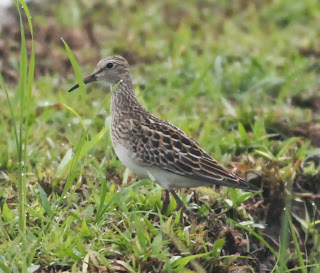While watching the harrier another new arrival in the form of a Purple Heron also took off out of the fields.
On the experimental station there are many new waders, particularly a lot of Long-toed Stints, and in amongst them a solitary juvenile Pectoral Sandpiper. The great run of waders continues!
What looks like a female Pied Harrier. My initial identification was Eastern Marsh, but the structure appears a little too lightweight for that. The head and particularly the bill seem a little small. This would be my first record of this species in The Philippines, and my first harrier of any kind at IRRI. It was severely mobbed by dozens of passerines. Lets hope it hangs around.
Any comments or corrections to this ID would be welcome!
The tail is interesting. Broad bands and a somewhat square tip suggest Pied.
The quantity of white on the rump is interesting, much more than would be expected on Eastern Marsh.
I took this to be a Sharp-tailed Sandpiper, however closer examination shows that it is in fact a juvenile Pectoral Sandpiper, a first record of this species from The Philippines! Thanks to Tom for pointing this out to me. A detailed analysis is here.
While taking photos of the Harrier this Purple Heron popped up out of the field in front of me.
Barred Rail. Not a migrant, but very obliging.







Glad you finally got a Harrier.... whatever it turns out to be.
ReplyDeleteAre you sure your 'Sharp-tailed Sandpiper' is really one? It looks rather like a juvenile Pectoral Sandpiper to me! Note at the strongly patterned breast (v-shaped), the unmarked flanks as well at the crown lacking rufous tones...
ReplyDeleteGreets Tom